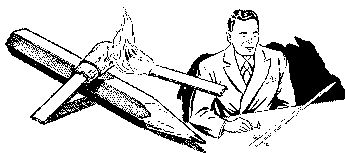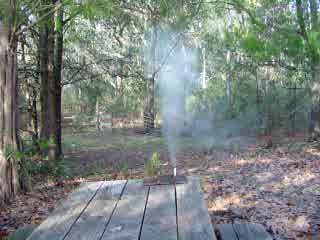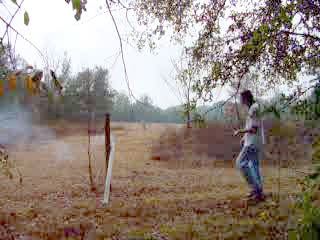
(Click for instructions)
Exhibit A: The match-rocket, inspiration for countless early rocketry experiments:
Of course I tried every imaginable variation on this theme. Most did not work. Then I discovered recrystallized KN/sucrose, which can be used to make larger versions of the match-rocket.
Here is how.
First, one must acquire some recrystallized KN/sucrose fuel. A small batch as illustrated on the website will do, making enough for a hundred or more of these little engines. It can be made ahead of time, as it keeps well when sealed against moisture and can be re-heated to form into shape.
Today I am using some made in late December of last year. It is one of the faster batches, burning at 9 seconds per inch at one atmosphere. Fast-burning candy is preferred for these rockets, not so much because of the faster burn rate but because it ignites more easily.
DO NOT attempt to re-heat this fuel in the microwave - it will ignite!
Then you will need a new microwave oven, perhaps a new kitchen and
possibly a new wife.
After about 15 minutes in a 200 degree toaster oven, this lump is as soft as modeling clay and easily rolled into 1/4 inch diameter sticks. I sprinkled a little bit of black powder on the board to give them some priming, which facilitates quick ignition. If you don't have black powder, just leave it off but your rockets will chuff a lot more, sometimes in the air. This can add to the excitement of a launch as well as enhancing the failure rate.
I have broken these sticks into segments about 1 inch long. Better a bit too short than too long. The engine will politely eject the fuel charge if there is too much of it. And here is a piece of the thin fuse I got from FireFox - it is excellent for making these little engines. Larger fuse works OK too. I guess you could rig up an electric ignitor as long as it didn't short out against the aluminum case.
Speaking of which, the case is made out of heavy-duty aluminum foil. Here it comes in rolls 18 inches wide. Tear off a piece 2 feet long. Fold it in half to make a double-thickness 1 foot by 18 inches, and fold again to make 1/2 foot by 18 inches. Then fold a third time to make a strip 3 inches wide, 18 inches long, and 8 layers thick. Smooth it flat, and cut into four sections, each 4-1/2 inches long by 3 inches wide by 8 layers thick. Each section will make one rocket engine.
Cut about three inches of fuse. Lay it on one of the foil strips next to a segment of fuel. The fuse should extend all the way to the head-end of the fuel charge, so as to give the fuel ample opportunity to ignite. Fold the foil over fuse and fuel, and roll it up tightly. Mash both ends flat with your fingers, and follow-up with a pair of pliers. When you do the fuse-end, make every effort to get the fuse centered between the flats. A good job can be accomplished by squeezing with the pliers on either side of the fuse, nudging it gently toward the middle.
Fold the head end over, crude and simple. If you roll it up neatly, it will unroll when the engine is fired. Crimp it lightly with the pliers just to make sure.
Here is one of my favorite tricks. Bend the flats on either side of the fuse to make an "S" shape. Start it with pliers, continue it with fingers, and finish it with pliers again. Make the foil flanges bend around the fuse like arms around a spiral galaxy.
Finish the "nozzle" by squeezing it uniformly round with pliers while
twisting it slightly.
I find the 6-inch locking pliers perfect for this job.
Be careful to avoid piercing or tearing the case, which is easy to
do at this point.
What a handsome little engine!
I hear it is a good idea to static-test any new engine design, so goes one:

Click on the photo above for a short video of this burn, provided mostly
for comic relief.
(Beware, 1.3 meg download for 15 seconds of video
of a very trivial test. Nice rustic birdsounds in the background,
though!)
Burn time 0.2 seconds, considerable tail-off.
While you were waiting for that to download, I made another engine. I want this one to fly, so a stabilizer will be attached. I've gotten rich and lazy enough to use store-bought sticks. In my poverty-stricken youth I would split these from a stalk of dry bamboo. These 12-inch skewers work pretty well, even though a bit short for my taste. The stick is attached with masking tape. Be sure to stretch the tape a bit as you make the first wrap - this will make the stick less wobbly.
It's raining, but I can't wait any longer. Must launch now!
Here is a video:

Click on the photo above for a short video of this flight.
(Beware, 1.4 meg download for 8 seconds of video.)
It's a vanishing act. A "whish," a short trail of smoke and it is somewhere out in the field. Admirers will be underwhelmed. So for the next one we will create a tiny starburst. I cut a square of paper toweling, wrap a few fragments of KN/sucrose in it with a pinch of black powder, lay a fuse on it an tie it up with sewing thread.
The payload is laid on the rocket with the towel-bundle at the head end and the fuse running down the side. It is covered in masking tape to hold it on, and the end of the fuse is taped to the rocket engine's ignition fuse so that when you light either one, it will ignite the other. The extra fuse-run to the top of the engine provides 3 or 4 seconds delay, which is about right for these little rockets.
So here it is. Kind of ugly looking by HPR standards, but it only took a few minutes to make.
KN/sucrose does not make a very impressive starburst. It burns with a pretty purplish flame but it is not very bright. I did not attempt to get a video of this launch, but it did work. These rockets will fly to a height of about 200 feet without a payload, perhaps 100 feet with a load such as this.
Sometimes I've put a single cut star of whatever color atop one of these rockets to make a tiny comet, or a firecracker for a report. But here we are getting into pyrotechnics, so I will back off. Perhaps the top-knot should contain a tiny parachute. Wouldn't that be cute!
Is this the smallest candy rocket? No, it is not. I have made an even smaller version, and it is a vtol rotary engine! I will submit that design soon. The "Most Trivial Rocket." Finally, an arena in which I can compete!
As always, comments, questions, complaints and snide remarks are welcomed.
My rocketry index page is at: www.jamesyawn.com
Jimmy Yawn
jyawn@sfcc.net
01/24/02